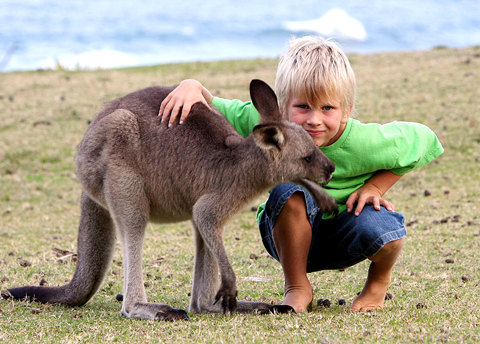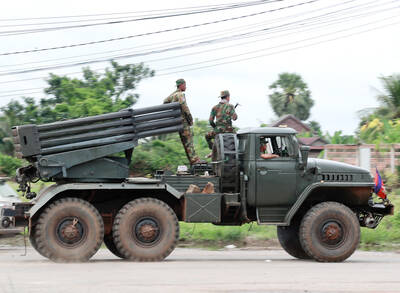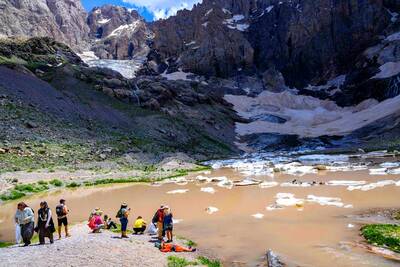Saving the planet by eating kangaroos and wild camels may seem like pie in the sky, but the offbeat menu comes with a scientific stamp of approval in Australia.
The aim in both cases is to reduce damage to the environment, but the reasoning behind the push to put the animals on the menu is sharply different.
In the case of kangaroos, environmentalists say the national animal should become a dietary staple in place of cattle and sheep as part of the fight against global warming.

PHOTO: AFP
The farm animals make a major contribution to Australia’s greenhouse gas emissions simply by belching and farting, while kangaroos emit negligible amounts of dangerous methane gas.
In other words, there should be more kangaroos and fewer farm animals.
“For most of Australia’s human history — around 60,000 years — kangaroo was the main source of meat,” the government’s top climate change adviser professor Ross Garnaut, said in a major report on global warming recently.
“It could again become important.”
In the case of camels, scientists say eating the imported animals would be one way of reducing the million-strong feral herd — one of the largest on earth — running amok in the fragile ecosystems of the outback.
“Eat a camel today, I’ve done it,” says professor Murray McGregor, co-author of a three-year study on the humpbacked pests presented to the government last month.
In each case, the scientists admit they face a struggle to change Australia’s eating habits, but believe strongly in the need to somehow cut the numbers of sheep, cattle and camels.
Garnaut’s study concluded that by 2020, beef cattle and sheep numbers could be reduced by 7 million and 36 million respectively, allowing for an increase in kangaroo numbers to 240 million by 2020, from 34 million now.
He acknowledged, however, that there were some problems in this plan, including livestock and farm management issues, consumer resistance and the gradual nature of change in food tastes.
The idea of farming kangaroos — which appear on the Australian coat of arms — for human consumption is distasteful to some, but many health-conscious Australians already eat kangaroo meat.
“It’s low in fat, it’s got high protein levels, it’s very clean in the sense that basically it’s the ultimate free range animal,” says Peter Ampt of the University of New South Wales’s institute of environmental studies.
A similar argument was put forward last month in an attempt to whet Australian appetites for camel meat.
A three-year study found that Australia’s population of more than a million feral camels is out of control and damaging fragile desert ecosystems, water sources, rare plants and animals.
The Desert Knowledge Cooperative Research Center, which produced the report presented to the federal government, said a good way to bring down the number of camels is to eat them.
“It’s beautiful meat. It’s a bit like beef. It’s as lean as lean, it’s an excellent health food,” McGregor said.
Unlike the native kangaroo, camels were introduced into Australia as pack animals for the vast outback in the late 19th and early 20th centuries, but were released into the wild as rail and road travel became more widespread.
With few natural predators and vast sparsely populated areas in which to roam, the population has soared to around a million and is now doubling about every nine years, the center’s Glenn Edwards said.
While putting camels on the menu could help reduce their numbers, and is one of the proposals in the report, Edwards admits it is unlikely that Australia can eat its way out of the problem.
Hundreds of thousands of camels will have to be removed to bring the numbers down to a point where they cause minimal damage, he said.
“I think [eating them] is an option that may work in some areas but it won’t be the panacea,” he said.
The local market for camel meat would be limited and even given the fact that there is a large demand from some countries overseas it would be difficult to harvest and process the animals.
Switching from cattle and sheep to kangaroos also faces problems, said beef farmer Kelvin Brown.
Transporting kangaroos to the abattoir would also be fraught with difficulties.

POLITICAL PATRIARCHS: Recent clashes between Thailand and Cambodia are driven by an escalating feud between rival political families, analysts say The dispute over Thailand and Cambodia’s contested border, which dates back more than a century to disagreements over colonial-era maps, has broken into conflict before. However, the most recent clashes, which erupted on Thursday, have been fueled by another factor: a bitter feud between two powerful political patriarchs. Cambodian Senate President and former prime minister Hun Sen, 72, and former Thai prime minister Thaksin Shinawatra, 76, were once such close friends that they reportedly called one another brothers. Hun Sen has, over the years, supported Thaksin’s family during their long-running power struggle with Thailand’s military. Thaksin and his sister Yingluck stayed

In the sweltering streets of Jakarta, buskers carry towering, hollow puppets and pass around a bucket for donations. Now, they fear becoming outlaws. City authorities said they would crack down on use of the sacred ondel-ondel puppets, which can stand as tall as a truck, and they are drafting legislation to remove what they view as a street nuisance. Performances featuring the puppets — originally used by Jakarta’s Betawi people to ward off evil spirits — would be allowed only at set events. The ban could leave many ondel-ondel buskers in Jakarta jobless. “I am confused and anxious. I fear getting raided or even

Kemal Ozdemir looked up at the bare peaks of Mount Cilo in Turkey’s Kurdish majority southeast. “There were glaciers 10 years ago,” he recalled under a cloudless sky. A mountain guide for 15 years, Ozdemir then turned toward the torrent carrying dozens of blocks of ice below a slope covered with grass and rocks — a sign of glacier loss being exacerbated by global warming. “You can see that there are quite a few pieces of glacier in the water right now ... the reason why the waterfalls flow lushly actually shows us how fast the ice is melting,” he said.

Residents across Japan’s Pacific coast yesterday rushed to higher ground as tsunami warnings following a massive earthquake off Russia’s far east resurfaced painful memories and lessons from the devastating 2011 earthquake and nuclear disaster. Television banners flashed “TSUNAMI! EVACUATE!” and similar warnings as most broadcasters cut regular programming to issue warnings and evacuation orders, as tsunami waves approached Japan’s shores. “Do not be glued to the screen. Evacuate now,” a news presenter at public broadcaster NHK shouted. The warnings resurfaced memories of the March 11, 2011, earthquake, when more than 15,000 people died after a magnitude 9 tremor triggered a massive tsunami that